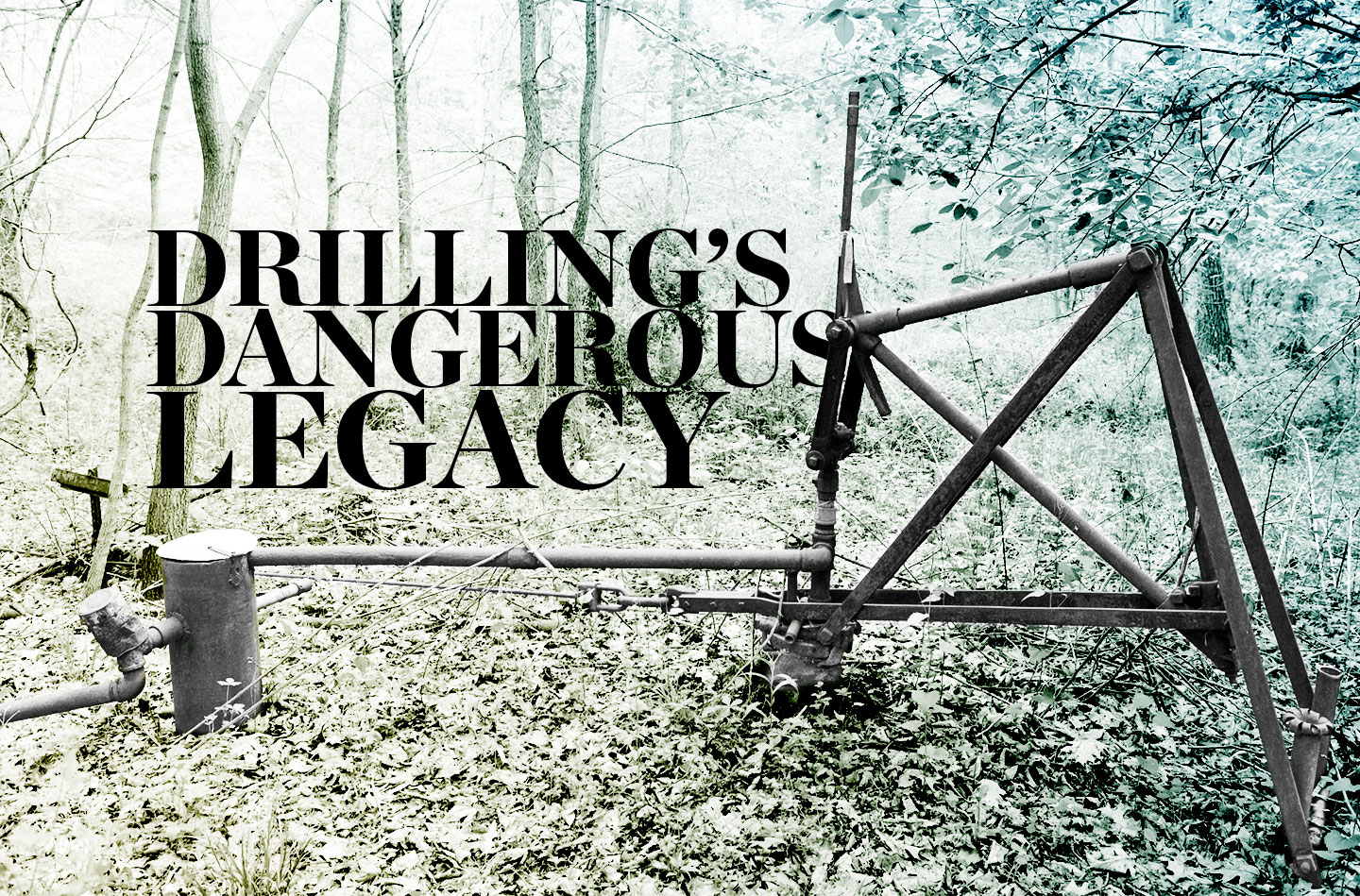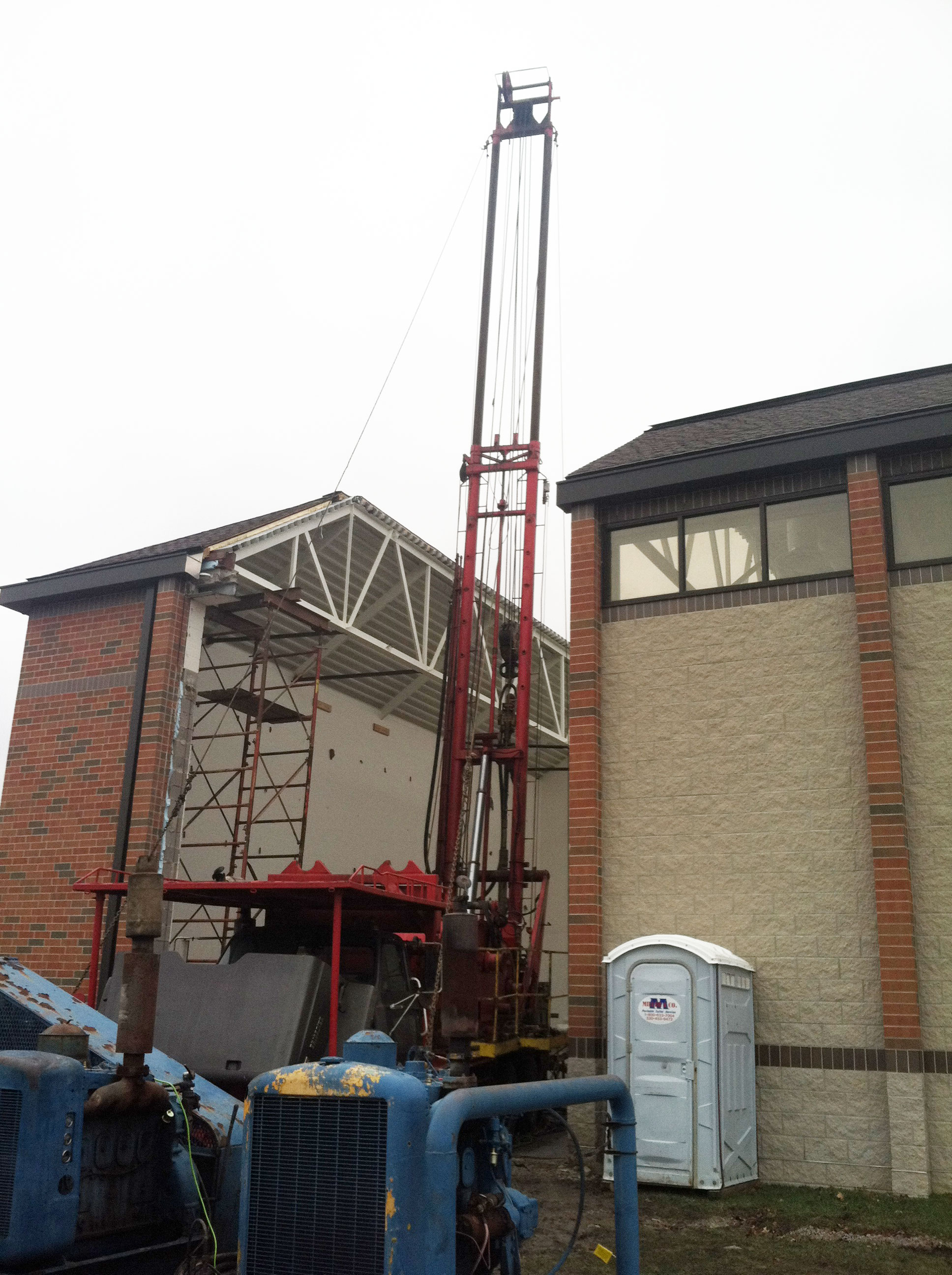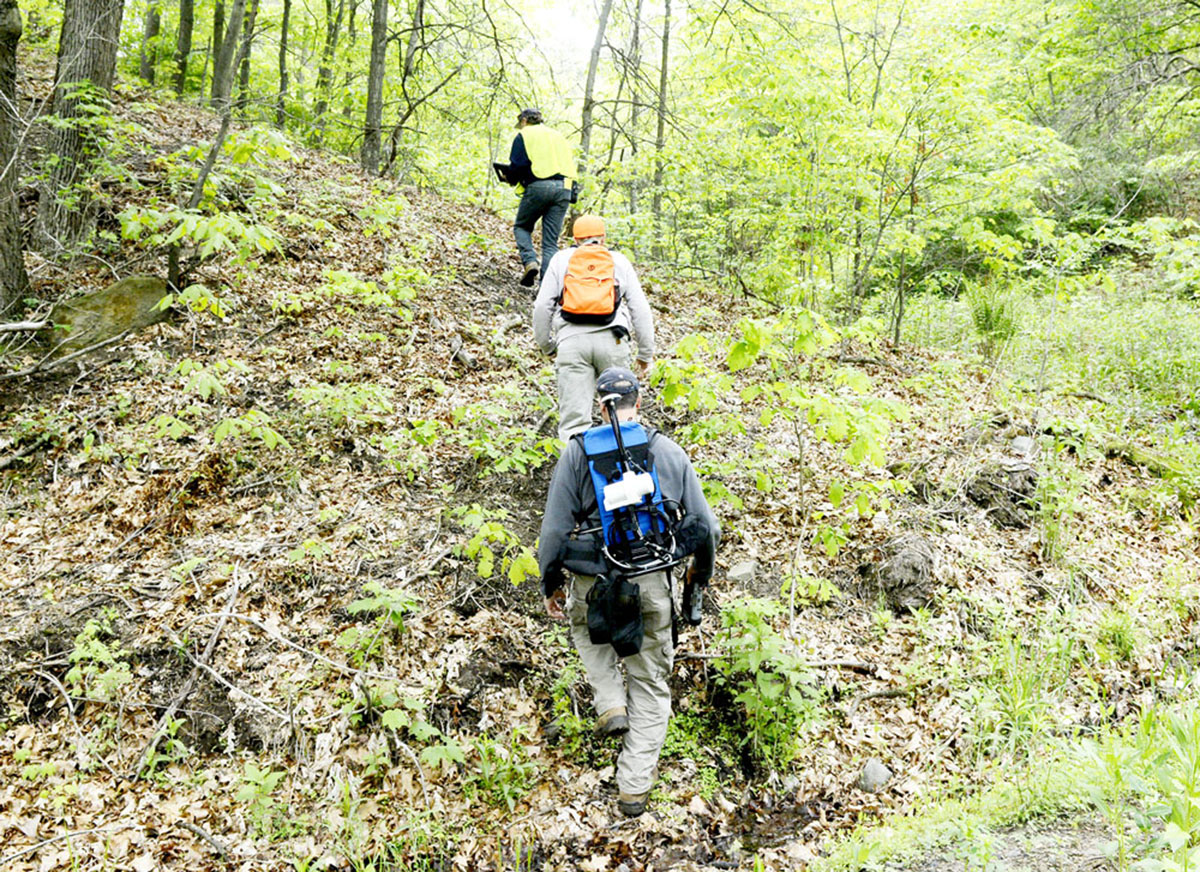
Abandoned wells can leak oil and explosive natural gas. Fracking can make the problem worse, but finding them first is a challenge.
By Shane Hoover / GateHouse Media
More than a million oil and natural gas wells were drilled in this country before anyone really knew how to plug them.
Once the oil or gas was gone, the wells were abandoned with little thought of future consequences. Some have been open holes in the ground since the 1800s. Others are plugged with little more than dirt and logs.
For decades, old abandoned wells have leaked oil, natural gas and brine into soil and drinking water, and posed an explosion risk.
The danger is often hidden. Hundreds of thousands of abandoned wells were never properly mapped. Many of the companies that drilled them no longer exist.
Abandoned wells lurk beneath homes and buildings in Ohio; under the busy streets of Los Angeles and the sparse Oklahoma plains; and in parks, backyards, forests, cornfields and cemeteries from Appalachia to the Pacific Ocean.
Abandoned wells are the unwanted legacy of 150 years of drilling booms and busts. Now those old wells pose a new danger as the country rides another petroleum boom driven by hydraulic fracturing techniques that unlock vast new reserves.

Between 2009 and 2014, U.S. annual oil production jumped 62 percent to 3.2 billion barrels. Annual natural gas production grew 26 percent to 27 trillion cubic feet. Together that's $1.8 trillion of new production, at contemporary prices.
Most drilling is concentrated in Texas, Oklahoma, North Dakota, Colorado, Pennsylvania, Ohio, West Virginia and Louisiana — a list that includes states with large numbers of abandoned wells.
To frack a well, water, sand and chemicals are injected underground with enough force to break rock. When abandoned wells are near the rock layer being fractured, the increased underground pressure can cause the old wells to leak oil and gas, similar to the way squeezing a juice box squirts liquid from the straw. Potentially toxic fracking fluid also can flow though old wellbores to other underground layers.
At the same time, new drilling generates money that states can use to find and plug abandoned wells.
Increased danger of contamination or explosions from abandoned wells has led to more aggressive efforts to find and plug old wells. In Pennsylvania, birthplace of the U.S. oil industry, the state is turning to citizen volunteers, scientists, drillers and archivists to find hundreds of thousands of abandoned wells. Pennsylvania is one of several proving grounds where new technology could lead the way for other states to locate and plug abandoned wells.
Legacy of abandoned wells
America's first oil boom started in 1859 in Titusville, Pennsylvania, then moved west as new discoveries were made, first in Ohio, West Virginia and Kentucky; then in Indiana, Illinois and Kansas. By the early 1900s, Oklahoma, Texas and California were becoming major producers.
As is the pattern in the oil industry, each boom led to a bust. Crude technology, bankrupt companies and poor drilling records seeded the ground with a dangerous crop of abandoned wells.
At least 4 million wells have been drilled since 1859. Of those, a million are still producing oil and natural gas. New wells are drilled each day.
Beneath the topsoil, the earth's crust is a layer cake of alternating bands of rock, sand and clay. Some layers hold freshwater; others oil and natural gas.
Drilling a well through thousands of feet of geological layers creates a passageway between the layers. Drillers line the hole with steel pipe held in place by cement. The steel and cement linings keep oil or gas from escaping into other layers of earth, and groundwater from leaking into the wellbore. Oil and gas can then rise to the surface.
After the supply of oil or gas is depleted, companies plug the well with a column of cement inside the steel pipe to prevent future leaks or seepage.
Old abandoned wells often fall short of modern plugging standards, or lack any plugs at all.
The oldest wells have casings made of wood instead of steel. Other old wells had their steel casings pulled from the ground for scrap metal during World War II.
In 1879, New York was the first state to make drillers plug unproductive wells. Other states followed. But the early rules were designed to keep water from flooding oil deposits. Groundwater protection only became important decades later.
Even with requirements, drillers plugged old wells on the cheap. The logs, clay and junk — even baseballs — used for plugs were temporary at best. According to the Interstate Oil and Gas Compact Commission, wells drilled before 1930 generally were not plugged with cement. And cement plugs used before the arrival of quality standards in 1952 didn't always harden properly.
An estimated 800,000 to 1 million wells were drilled before 1930. A fifth of them produced nothing, and the average life of producing wells ranged from eight years in 1890 to 21 years in 1930.
That left a lot of old wells across the country with questionable plugs, or no plugs at all.
Subterranean danger
Abandoned wells without proper plugs put the public and the environment at risk.
Oil, natural gas and brine seeping from the old wells can pollute groundwater, and flow to the surface to contaminate soil, rivers and lakes. Natural gas leaked from an abandoned well is a potent greenhouse gas, and can collect inside a building and explode. vIn 2011, a Groundwater Protection Council study found that abandoned wells caused 41 incidents of groundwater contamination in Ohio between 1983 and 2007, and another 30 in Texas between 1993 and 2008. None of those incidents was related to fracking.
A U.S. Geological Survey study from 1988 found that brine from abandoned wells polluted part of the groundwater supply for 50,000 people in West Point, Kentucky, and nearby Fort Knox.
Some abandoned wells may pose little or no noticeable danger for decades. But when new underground pressure from hydraulic fracturing drives material through subterranean layers of rock and soil, the old wells take on new significance as potential sources of pollution and dangerous explosions.
Pennsylvania has documented at least seven cases since the late 1990s where fracking a new well caused gas and fluids to leak from nearby abandoned wells, a phenomenon called communication.
"As you drill more wells," said Andrew Williams, of the Environmental Defense Fund, "you have more risk of communication between existing wells and the new wells being drilled."
In one of the Pennsylvania incidents, natural gas seeped underground to within 8 feet of a home. Natural gas from abandoned wells can be very dangerous when it collects inside buildings. In 1985, gas leaking from a fault and an abandoned well exploded in a Los Angeles department store, injuring two dozen people.

In Ohio, cities on the southern shore of Lake Erie, including Lorain and Cleveland, are dotted with old gas wells drilled in the late 1800s and early 1900s to supply homes and light street lamps. The Lorain fire department keeps a list of 135 old wells in the city and nearby communities.
Last October, Lorain officials evacuated staff and 350 students from the recently built Admiral King Elementary after detecting a gas leak.
When the fire department and the gas company found no problems with the pipes, the Ohio Department of Natural Resources went looking for an abandoned well. A five-week search at the school revealed an abandoned well under a corner of the gym.
Workers had to remove part of the gym wall and roof to reach the well with plugging equipment. Students couldn't return to school until after Christmas. The gym's footprint is being changed so the well is outside the building.
"When you go into these," said Eugene Chini, head of Ohio's plugging program, "you don't know what you're going to run into."
State enforcement
Each state regulates oil and gas drilling within its borders. So the responsibility of ensuring abandoned wells are identified and plugged resides at the state level. States differ in terms of the number of abandoned wells and the resources to plug them.
Companies that own wells are responsible for plugging them, but bankruptcies and the passage of decades can make ownership difficult to determine.
Abandoned wells without identifiable owners are called "orphan wells." States first started plugging orphan wells in the 1960s. In the 1970s, passage of the federal Safe Drinking Water Act strengthened state rules on plugging to better protect groundwater.
According to the Interstate Oil and Gas Compact Commission, at least half of the states have some sort of plugging program today, usually within the agency that regulates oil and gas drilling.
The money to plug wells generally comes from fees, bonds and taxes paid by the oil and gas industry, so funding levels fluctuate with the amount of drilling activity in a state. States also can use federal funds to plug abandoned wells to protect navigable waterways.
Well plugging is expensive. Average costs vary widely — from less than $3,000 to more than $1 million in the case of an offshore well — depending on the terrain, depth of the well and the particulars of the geological layer cake. Unable to plug every well, states plug the most dangerous ones first.
Texas, where more than 1 million wells have been drilled, spends the most on its plugging program. Since 1984, the state has spent $240.3 million to plug 34,423 wells. Last year, it plugged 563 wells for $15 million. Still, Texas's population of orphan wells has grown from 7,036 at the end of 2010 to 9,349 at the end of 2014.
Other state programs for plugging wells are less effective.

Recent legislative audits in Louisiana and West Virginia faulted those states' programs for lax inspections and enforcement. And in Illinois, lawmakers have transferred money from the state's plugging fund to be used for other things.
Still, the recent drilling boom in some parts of the country has increased the amount of money states have for plugging.
Mike Nickolaus, special projects director of the Groundwater Protection Council, said 19 states plugged more than 15,000 wells from 2008 to 2013.
"Generally speaking, I think the situation is improving with respect to orphan wells," Nickolaus said.
In Ohio, where horizontal drilling in the Utica Shale is boosting the state's oil and natural gas production, the Department of Natural Resources has hired more staff for its plugging program, and the fund for plugging wells has more than tripled to $1.5 million since 2011.
But more drilling activity can slow efforts to plug abandoned wells. Companies that plug abandoned wells also work on new wells. Increased demand for their services during the drilling boom has driven up plugging costs.
Also, increased production has led to lower oil and natural gas prices and slowed the pace of drilling. That means less money for states such as Pennsylvania that get most of their plugging funds from surcharges on well permits.
Lower oil and natural gas prices also put financial pressure on well owners, who may abandon wells in the wake of bankruptcy.
"Whenever prices are down, money is tight," said Williams of the Environmental Defense Fund. "But that doesn't lessen the need for the state to deal with this important issue of orphan and abandoned wells, and the potential environmental risks associated with not dealing with them."
Hunting abandoned wells
Before states can plug abandoned wells and reduce the risk to the public and the environment, they need to find them. That can be a challenge in states with long histories of drilling, multiple boom-bust cycles and vague or missing records.
Pennsylvania, cradle of the first oil boom, is a prime example. Increased drilling in the state has focused state regulators on finding and plugging unmapped abandoned wells. Detection methods being tested in the state could be used to find abandoned wells across the country.
The state has plugged about 3,000 abandoned wells and has another 8,300 on its official list.
But Pennsylvania's Department of Environmental Protection estimates the state has 100,000 to 300,000 abandoned wells. Others say the number is closer to half a million. An exact count is difficult because the state didn't require permits for all oil and gas wells until the early 1960s, a century after the first wells were drilled.
Pennsylvania is crafting new rules that would make drillers locate active, inactive, orphan and abandoned wells within 1,000 feet of a gas well or horizontal oil well, and within 500 feet of a vertical oil well before fracking takes place. Orphan or abandoned wells altered by fracking would have to be plugged by the driller or placed into production. The goal is to have the rules finalized by 2016.
"As we've done historically, this burden is being shifted appropriately, I think, toward industry," said Seth Pelepko, chief of DEP's division of well plugging and subsurface activity.
To identify abandoned wells, the state has digitized and archived information on more than 30,000 sites, and is getting more information from citizen volunteers, landowners, drillers and researchers.
In the north-central part of the state, Mansfield University geography professors Andrew Shears and Lee Stocks Jr. are using old records, ground-penetrating radar and aerial photography by drone to identify and examine well sites. The information they gather eventually will be made available to the state.
"It's a detective search, in a way," Shears said.
In western Pennsylvania, scientists from the U.S. Department of Energy's National Energy Technology Laboratory are searching for abandoned wells with aerial magnetic surveys. vA steel well casing is magnetic and can be detected by sensors mounted on a low-flying helicopter. When the magnetic survey readings are combined with GPS data, the suspected wells appear on a map as rainbow-colored bulls'-eyes. The colors represent the strength of the magnetic field.
The laboratory team has used magnetic surveys to find wells in the flat, open terrain of Wyoming, and is testing how the method works in the forested hills of Pennsylvania.
In the summer of 2014, the team flew aerial magnetic surveys of Susquehannock State Forest, Hillman State Park and Oil Creek State Park.

This spring, the team started hiking Hillman's 3,600 acres of swamps and tick-infested woods to verify the results of the aerial survey and measure the amount of gas leaking from selected abandoned wells. The park is a challenging proving ground because the land was drilled for oil between 1890 and 1910, and some areas were later surface-mined for coal. In the process, some well casings were cut off and wells buried under mounds of mine debris.
Still, aerial and ground magnetic surveys, combined with information from historic maps and old aerial photos, have revealed close to 200 possible wells, far more than the approximately 30 listed for the park in a state database.
"As it turns out, it works really, really well," said Garret Veloski, a scientist on the monitoring team.
But aerial magnetic surveys have their limits. They won't find wells without steel casings or related metal parts, such as pipelines. And they're expensive. The three-park study, plus the related survey of 180 miles of pipeline, is costing the lab approximately $360,000, said Richard Hammack, monitoring team lead.
Replacing helicopters with unmanned aircraft, or drones, carrying miniaturized sensors could cut the cost. The technology is in development.
If the drones work, Pennsylvania, and other states, could have a more efficient way to find, and ultimately plug, their dangerous legacies of abandoned wells.
Shane Hoover, reporter for The Repository in Canton, Ohio, spent one month away from his newsroom to research and write about dangers of old wells as part of GateHouse Media's national Pinnacle project reporting program. He covers the oil and gas industry, and has been interested in the intersection between the recent resurgence of drilling and Ohio's long history of oil and gas exploration. This story is the product of more than two dozen interviews, visits to abandoned well sites in Ohio and Pennsylvania, and more than 20 public records requests.